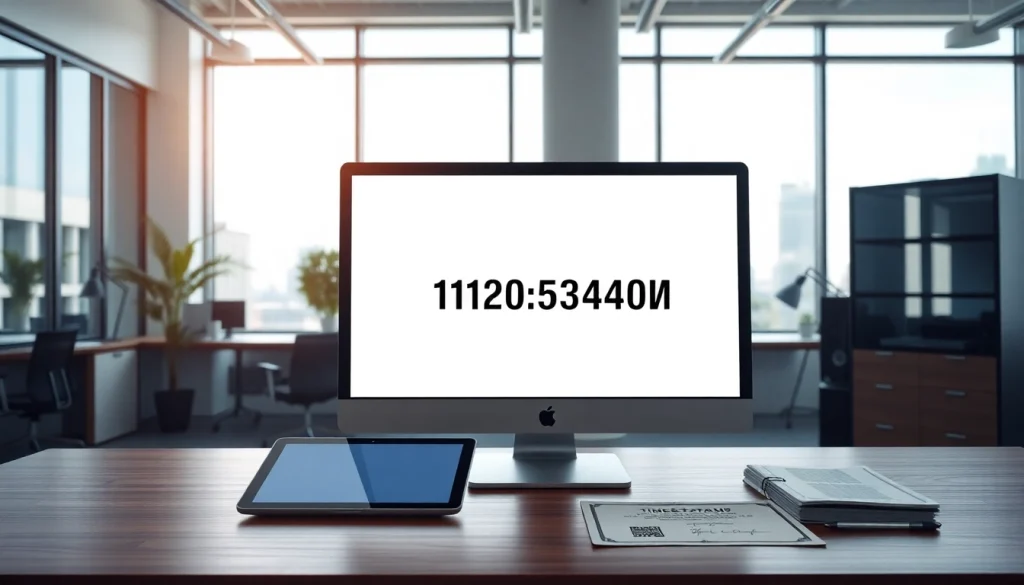Validating Digital Integrity: How to Securely Timestamp Document Online

Understanding Timestamp Documents
In the digital age, the integrity of documents is paramount. Timestamping documents is a pivotal practice that ensures the authenticity and chronological accuracy of digital files. This process is vital not only for businesses but also for individuals who need to provide proof of when a document was created or modified. Understanding how to timestamp document online is essential for anyone looking to safeguard their digital assets effectively.
What is a Timestamp Document?
A timestamp document is essentially any digital file that has been marked with a specific time and date. This timestamp denotes when the document was created, altered, or finalized, providing a crucial record that can be used in various contexts, including legal, business, or personal matters. A timestamp can serve as a digital seal of authenticity, granting users confidence in the integrity of the document’s content.
Importance of Timestamping for Digital Integrity
The importance of timestamping lies in its role in ensuring digital integrity. When documents are timestamped, they are fortified against unauthorized changes. Timestamping creates a verifiable trail that can resolve disputes regarding the authenticity and timing of document creation or edits. This feature is particularly valuable in legal scenarios, where the chronology of documents can influence case outcomes significantly. More importantly, a proper timestamp provides peace of mind for users, knowing that their digital property is protected.
Types of Timestamping Methods
Several methods exist for timestamping documents, which can be categorized into three primary types:
- Digital Signatures: A digital signature uses encryption techniques to validate the authenticity of a document, embedding a timestamp during the signing process.
- Timestamp Authorities (TSA): These are trusted entities that issue timestamps for digital documents, ensuring that they are recognized as valid in legal and transactional contexts.
- Self-Generated Timestamps: Users can create their timestamps using software tools. However, these timestamps may lack the official validation that comes from a trusted timestamp authority.
How to Timestamp Documents Online
Timestamping documents online is a straightforward process that can be facilitated through various digital platforms. Understanding how to navigate and utilize these services effectively is key to ensuring document integrity.
Step-by-Step Guide to Online Timestamping
Stamping your document online typically follows a few essential steps:
- Select an Online Timestamp Service: Choose a reputable online timestamping service that suits your needs. Options include FreeTSA, True Timestamp, and OpenTimestamps.
- Upload Your Document: Most services allow you to upload the file you wish to timestamp directly from your device.
- Complete the Timestamping Process: Follow the prompts provided by the service, which may include selecting timestamp settings and any additional features you wish to employ.
- Download Your Timestamped Document: Once the process is complete, download the timestamped document, containing verifiable proof of its time and date.
Choosing the Right Timestamping Service
Selecting the appropriate timestamping service requires careful consideration. Here are a few factors to evaluate:
- Reputation: Opt for services with positive reviews and a strong industry reputation for reliability.
- Compliance: Ensure that the service meets legal standards for timestamping in your jurisdiction.
- Cost: Consider whether the service offers free options or premium features, and evaluate which best aligns with your budget and needs.
Cost Considerations for Timestamping
The cost of timestamping can vary significantly based on the service provider and the features you require. While some basic timestamping services are free, more advanced options that include additional security features or integrate with other software may come at a cost. It’s essential to weigh these options against your specific needs and the potential benefits they offer.
Legal Implications of Timestamping
Timestamping is not just a matter of convenience; it also carries significant legal implications that must be understood by anyone using digital documents.
Timestamp Documents and Their Legal Validity
The legal validity of timestamped documents is a crucial consideration. In many jurisdictions, timestamping can serve as a strong piece of evidence in legal disputes, establishing when a document was created or modified. This legal standing varies between countries, so understanding your local laws regarding digital documents is imperative.
How Timestamping Affects Copyright and Ownership
Timestamping also plays a crucial role in copyright and ownership assertions. By providing a verifiable date of creation for a work, it helps in protecting intellectual property rights. If a copyright dispute arises, a timestamp can help establish when an idea or creation was documented, thus solidifying the creator’s claim to ownership.
Compliance Standards for Digital Documents
In today’s digital landscape, various compliance standards govern the management of documents. It is essential to ensure that timestamping practices align with regulations such as the General Data Protection Regulation (GDPR) in the EU and the Health Insurance Portability and Accountability Act (HIPAA) in the US. Compliance not only protects businesses from legal repercussions but also fosters trust with clients and customers.
Best Practices for Timestamping Documents
To maximize the effectiveness of timestamping, adopting best practices is essential for ensuring data security and integrity.
Ensuring Data Security While Timestamping
Data security is paramount when dealing with digital documents. Use reputable timestamping services that encrypt your data securely. Additionally, avoid sharing sensitive information unnecessarily and ensure that your documents are stored in secure environments.
Integrating Timestamping in Workflows
Incorporating timestamping into your workflow can streamline processes and ensure that all document actions are verifiable. For businesses, integrating timestamping into document management systems can help maintain organized records, reinforce accountability, and simplify audits.
Common Mistakes to Avoid
Here are a few common pitfalls to avoid when timestamping documents:
- Neglecting Verification: Always verify that the timestamp has been applied correctly and that the document is satisfactory.
- Ignoring Legal Standards: Ensure that the timestamping process complies with local laws and regulations.
- Overlooking Security Measures: Not implementing adequate security measures can leave documents vulnerable to manipulation.
Future Trends in Timestamping
The realm of timestamping is continuously evolving, spurred by advancements in technology and changes in legal frameworks.
Emerging Technologies in Digital Timestamping
New technologies are shaping the future of digital timestamping. Innovations such as Artificial Intelligence (AI) and Machine Learning (ML) are enhancing how timestamps are managed and verified, providing more robust systems for document validation and ensuring higher levels of security.
The Role of Blockchain in Timestamping
Blockchain technology is emerging as a powerful tool for creating immutable records, including timestamps. This decentralized approach enhances security, making it nearly impossible to alter backend records once they are stamped. Many timestamping services are beginning to adopt blockchain to ensure the authenticity and integrity of timestamps.
Predictions for Timestamping Authority Services
Looking ahead, timestamping authority services are projected to become more widespread and indispensable across various industries. As digital transactions and remote working continue to rise, the demand for trusted timestamps will increase, leading to innovations in how these services operate and the fees associated with them.







